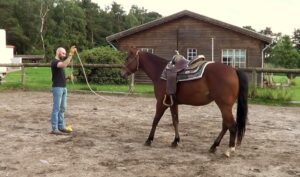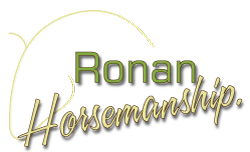Backing up a horse is the second fundamental to build a strong and mutual respect. You do not run over your horse and he should not run over you: especially because he weights more than four times your weight! This exercise is designed to teach horses the notion of our personal space.
1 ) horses learn when you release pressure.
2 ) timing is essential to good horsemanship, recognize the signs of relaxation to make sure you release right on time: blinking eyes, lowering the head and neck, chewing mouth, cocking a hind leg.
Position
Security

Process
Raise your hand at the level of the horse’s eyes, that will catch his attention and you are sure he is focused on your cue. Wiggle lightly the rope and wait for your horse to shift his weight back, then stop and pet him as a reward. Repeat the process and keep wiggling until the horse moves one leg back, whatever the leg, just one step back, release pressure and stroke. You will ask a little more every time you reach a new level: a couple of steps back, a couple of meters, etc.
Q&A

What if my horse does not move at all or shows disrespect?
Make sure you give enough time to your horse to understand what you ask. Yet, if you have no response after a few seconds, then you ought to offer the second deal, that is to bump on the lead rope. That move should not be hard or aggressive, but clearly firm enough to obtain a response (shifting the weight back, raising a foot, moving one step back, etc.). Next time, you start with the gentle deal again first, wait for a few seconds, and use the second deal only if you did not have any response at all. Pretty soon, you will not need to use the second deal at all.
What if my horse does not respond when I bump the rope?
There are two possibilities, either your bumping is too light and does not disturb your horse enough, then adapt your gesture to be firm enough to get a response; or, the horse is very dominant and disrespectful, then you could use the Australian method as a second deal: take your flag in the other hand, go through the normal process first, then if you have no response wave the flag under the horse’s chin, finally tap his breast until he moves back.
What if my horse starts to move from one side to the other?
Your horse explores the different possibilities as he does not know naturally what you ask for. That is the reason why you should be particular with your position and timing: stay right in front of him and make sure you keep his head straight in line, every time you feel he tries to go left or right, rearrange your position and pull the head in front of you. Pretty soon, your horse will understand that the only direction that offers peace is in his back, then he will start to back up and that is when you should release pressure, pet him and let him soak the information.
What if my horse gets spooky every time I raise the hand?
He does not trust you and needs to feel comfortable around you before being able to understand this cue. You should desensitize him more around the head. Wave your hand quickly in front of your horse and stop this as soon as he stands still and shows a sign of relaxation.
During the working session, always keep in mind that you ought to give your horse a few seconds to soak the information, as soon as he gets your cue, let him think! Once you feel your horse gets it, stop working, leave him for the rest of the day and you will see the difference the day after.

 ENGLISH
ENGLISH DEUTSCH
DEUTSCH ESPAÑOL
ESPAÑOL FRANÇAIS
FRANÇAIS